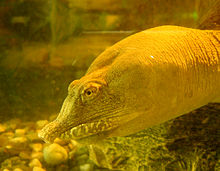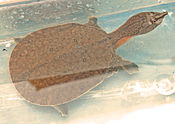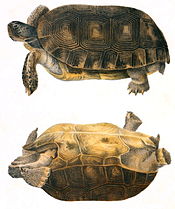- Chinese softshell turtle
-
Chinese softshell turtle 
Conservation status Scientific classification Kingdom: Animalia Phylum: Chordata Class: Sauropsida Order: Testudines Family: Trionychidae Genus: Pelodiscus Species: P. sinensis Binomial name Pelodiscus sinensis
Wiegmann, 1835The Chinese softshell turtle (Pelodiscus sinensis), formerly known as Trionyx sinensis[1], was described by Wiegmann in 1835. The species is also referred to as the Asiatic Soft Shelled Turtle.
There is a subspecies japonicus which is sometimes erroneously listed as Pelodiscus japonica.
Contents
Appearance
The Chinese softshell turtle can reach a carapace length of 1 foot (30.3 cm). It has webbed feet for swimming.
Diet
It forages at night, taking crustaceans, molluscs, insects, fish, and amphibians.
Habitat
With its long snout and tubelike nostrils, the Chinese soft-shelled turtle can "snorkel" in shallow water. When resting, it lies at the bottom, buried in sand or mud, lifting its head to breathe or snatch at prey.
Distribution
The Chinese softshell turtle is found in China (including Manchuria and Taiwan), Korea, North Vietnam and Japan, and Russia.[2]
It is difficult to determine its native range due to the long tradition of use as a food and "tonic"[3] and subsequent spread by migrating people[4]. The Chinese soft-shelled turtle has been introduced to Malaysia, Singapore, Thailand, Timor, Batan Islands, Guam, some of the Hawaiian Islands[5] California and Virginia.[6]
Reproduction
17 to 28 eggs are laid per clutch, two to four times a year.
Animal Husbandry
The Chinese Softshell Turtle (Pelodiscus sinensis) is the turtle species raised on China's turtle farms. According to the data obtained from 684 Chinese turtle farms, they sold over 91 million turtles of this species every year; considering that these farms represented less than half of the 1,499 registered turtle farms in China, the nationwide total could be over twice as high.[7]
These turtles can be injured if they are dropped or hit, and are susceptible to shell fungus. Within Europe, the turtle is a popular pet, particularly in countries such as Italy and the Czech Republic.
Turtles as human food
Turtle soup is made from this species.
References
- ^ UniProt Taxonomy - Trionyx sinensis
- ^ Distribution map from WWF: shows the species' distribution within NE China and Russian Far East
- ^ Louis A. Somma. 2009. Pelodiscus sinensis. USGS Nonindigenous Aquatic Species Database, Gainesville, FL. [1] Revision Date: 6/29/2004 Accessed: 15/05/2009
- ^ C.H. Ernst, R.G.M. Altenburg & R.W. Barbour - Turtles of the World - Pelodiscus sinensis [2]
- ^ Brock, V. E. 1947. The establishment of Trionyx sinensis in Hawaii. Copeia 1947(2):142
- ^ Mitchell, J.C., B.W. Steury, K.A. Buhlmann, and P.P. van Dijk. 2007. Chinese softshell turtle (Pelodiscus sinensis) in the Potomac River and notes on eastern spiny softshells (Apalone spinifera) in Northern Virginia. Banisteria 30:41-43.
- ^ Shi, Haitao; Parham, James F; Fan, Zhiyong; Hong, Meiling; Yin, Feng (2008-01-01), "Evidence for the massive scale of turtle farming in China", Oryx (Cambridge University Press) 42: 147–150, doi:10.1017/S0030605308000562, http://journals.cambridge.org/action/displayFulltext?type=1&fid=1738732&jid=ORX&volumeId=42&issueId=01&aid=1738724, retrieved 2009-12-26
External links
Bibliography
- Wiegmann, A. F. A. 1835. Beiträge zur Zoologie, gesammelt auf einer Reise um die Erde, von Dr. F. J. F. Meyen. Amphibien, Nova Acta Acad. Leopold.-Carol. 17: 185-268.
Trionychidae family of turtles Genus Species of the Cyclanorbinae subfamily
Cyclanorbis Cycloderma Aubry's flapshell turtle · Zambezi flapshell turtleLissemys Burmese flapshell turtle · Indian flapshell turtleSpecies of the Trionychinae subfamilyAmyda Apalone Chitra Asian narrow-headed softshell turtle · Burmese narrow-headed softshell turtle · Indian narrow-headed softshell turtleDogania Nilssonia Black softshell turtle · Burmese peacock softshell · Ganges softshell turtle · Indian peacock softshell turtle · Leith's softshell turtlePalea Wattle-necked softshell turtlePelochelys Cantor's giant softshell turtle · New Guinea giant softshell turtle · Northern New Guinea giant softshell turtlePelodiscus Chinese softshell turtle · Hunan softshell turtle · Lesser Chinese softshell turtle · Northern Chinese softshell turtleRafetus Euphrates softshell turtle · Yangtze giant softshell turtleTrionyx African softshell turtlePhylogenetic arrangement of turtles based on turtles of the world 2010 update: annotated checklist of taxonomy, synonymy, distribution and conservation status. Order Testudines (turtles) Kingdom: Animalia · Phylum: Chordata · Class: Reptilia · Subclass: Anapsida · Order: Testudines Suborder SuperfamilySubfamily
Cryptodira Chelydra · MacrochelysCaretta · Chelonia · Eretmochelys · Lepidochelys · NatatorDermochelysDermatemydidaeDermatemysStaurotypinaeClaudius · StaurotypusBatagur · Cuora · Cyclemys · Geoclemys · Geoemyda · Hardella · Heosemys · Leucocephalon · Malayemys · Mauremys · Melanochelys · Morenia · Notochelys · Orlitia · Pangshura · Rhinoclemmys · Sacalia · Siebenrockiella · VijayachelysAldabrachelys · Astrochelys · Chelonoidis · Chersina · Cylindraspis · Geochelone · Gopherus · Homopus · Indotestudo · Kinixys · Malacochersus · Manouria · Psammobates · Pyxis · Stigmochelys · TestudoTrionychiaCarettochelyidaeCarettochelysTrionychinaePleurodira ChelidinaeChelodininaeHydromedusinaePelomedusa · PelusiosPhylogenetic arrangement based on turtles of the world 2010 update: annotated checklist. Extinct turtles not included.
See also List of Testudines families
 Portal ·
Portal ·  WikiProjectCategories:
WikiProjectCategories:- IUCN Red List vulnerable species
- Pelodiscus
- Biota of Hong Kong
- Reptiles of Japan
- Introduced reptiles of Hawaii
Wikimedia Foundation. 2010.

